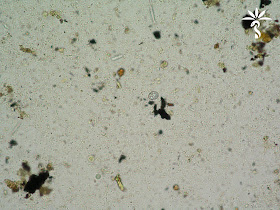It's the first Monday of the month, and time for our case from Idzi Potters and the Institute of Tropical Medicine, Antwerp. The following objects were seen on a wet mount (with iodine) of a concentrated stool specimen (400x original magnification).Size is between 15 and 20 µm in length.
Here is another view on a carbolfuchsine staining according to Heine (1000x). Identification?




Could be an immature oocyst of Cystoisospora belli with two sporoblast??
ReplyDeleteOne oocyst and single sporocysts of Sarcocystis sp.
ReplyDeleteMarianne L
The objects appear retractile, compatible with coccidian oocysts. They stain partially acid fast as do Crypto, Cyclone and Isospora. Cryptosporidium oocysts measure 4-6nm. Cyclos are 8-10nm. Isospora oocysts average 25-30 nm. The last choice remaining is Sarcocystis so.
ReplyDeleteFlorida Fan
Sporulated oocysts of Sarcocystis spp.
ReplyDeleteI totally agree with Florida Fan. Going by size differentiation of coccidian parasites, this is most likely a Sarcocystis spp. oocyst.
ReplyDeleteNice shot! Sarcocystis spp. oocysts are not easy to find.
Yes, Sarcocystis, either S. hominis or S. suihominis in the human host. I have seen this a few times during my CDC days, all from Burmese refugees from Myanmar.
ReplyDeleteI agree with Blaine and others that it is one of the species Sarcocystis that infect humans. The sporocysts look very much like what we see in fecals from various animals in our diagnostic lab.
ReplyDeleteAhh another treat from across the pond. There are four things from Belgium I really like. Belgian beer, my glasses frame, Dr. A. Fain, and Idzi's monthly unknows.
ReplyDeleteThese wonderful specimens provide the visuals for nice teaching moment.
The Critters are a coccidian of the family Sarcocystidae which differ from the members of Eimeridae (Isospora and Eimeria) in several important ways.
1. Sarcocystids have an intermediate host (a carnivore) and a definitive host (an herbivore). Eimerids complete their life cycle in a single host.
2. The oocyst of Sarcocystis form within the gut cells of the definitive host and are found in the feces as sporulated oocysts, but mostly as sporulated sporocysts (formed within these oocysts). Eimerids present in the feces as unsporulated oocysts which appear as an egg-shaped shell containing a spherical sporont. These oocyst will sporulate only under higher oxygen tension (outside the host). Note : if you find sporulated oocysts in fresh feces it is probably a spurious find.
3. Sarcocystis sporulated oocyst contain 2 sporocyst each containing 4 banana shaped sporozoites also one can see a cluster of bubble like structures (the residium)which can all be seen in the photos. Sporulated Eimerids are variable. Isospora has 2 sporocysts each containing 4 sporozoites, Eimeria contain 4 sporocysts each containing 2 sporozoites.
Humans act as a definitive host for Sarcocystis hominis (cattle intermediate), and S. suihominis (swine intermediate). The symptoms are mild to non existent. It is probably one of these two species shown in these photos. Cannot differentiate the 2 species with a light microscope.
A few humans have contracted aberrant infections of S. nesbitti. Humans act as an intermediate host and Sarcocystis occurs as a muscle parasite with no structures occurring in feces.
Piccole sporocisti di Sarcocystis hominis.
ReplyDeleteWaaw Old One... placing me in the same listing as Belgian beers and Dr. Fain! Different feelings are coming up now, amongst which “flattered” and “honored” :-)
ReplyDeleteI’m very glad to hear that these pictures and videos are of help in teaching and learning moments! So in turn I thank Dr. Pritt once more for this wonderful opportunity I have been given!
To the case: for those who might wonder what technique was used for that last picture: it was stained using the negative carbolfuchsine staining according to Heine. This technique is used at ITM to screen for Crytosporidium, but one might of course stumble onto other things as well... ;-)
I learn from this case. Thank you
ReplyDeleteOld One,
ReplyDeleteJust one more thing from Belgium:" Le chocolat belge est de réputation mondiale ". So at least get a sample of this succulent treat.
Florida Fan
I have a friend who took a wonderful river cruise from Belgrade to Belgium. A person of many interests, despite all the wonderful things he saw, all he could talk about were the Belgium chocolates.
ReplyDeleteI must try some.
Honestly I don't like Belgian (or European) chocolates for the most part. Too milky. Give me the dark 60-80% cocoa ones :)
ReplyDeleteBlaine are you a fan of Dark ales and stouts?
ReplyDelete